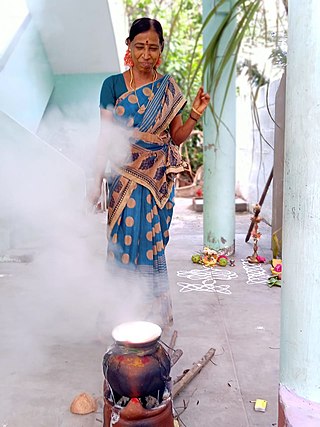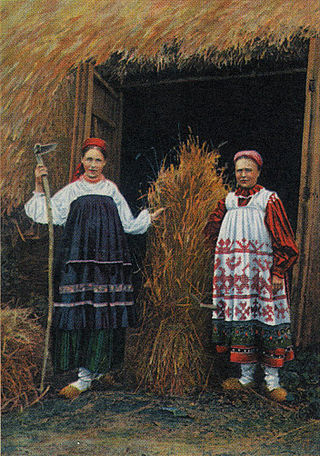
Lammas, also known as Loaf Mass Day, is a Christian holiday celebrated in some English-speaking countries in the Northern Hemisphere on 1 August. The name originates from the word "loaf" in reference to bread and "Mass" in reference to the Eucharist. It is a festival in the liturgical calendar to mark the blessing of the First Fruits of harvest, with a loaf of bread being brought to the church for this purpose. Lammastide falls at the halfway point between the summer solstice and the autumn equinox. Christians also have church processions to bakeries, where those working therein are blessed by Christian clergy.

May Day is a European festival of ancient origins marking the beginning of summer, usually celebrated on 1 May, around halfway between the Northern Hemisphere's Spring equinox and June solstice. Festivities may also be held the night before, known as May Eve. Traditions often include gathering wildflowers and green branches, weaving floral garlands, crowning a May Queen, and setting up a Maypole, May Tree or May Bush, around which people dance and sing. Bonfires are also a major part of the festival in some regions. Regional varieties and related traditions include Walpurgis Night in central and northern Europe, the Gaelic festival Beltane, the Welsh festival Calan Mai, and May devotions to the Blessed Virgin Mary. It has also been associated with the ancient Roman festival Floralia.

The Mid-Autumn Festival, also known as the Moon Festival or Mooncake Festival, is a harvest festival celebrated in Chinese culture. It is held on the 15th day of the 8th month of the Chinese lunisolar calendar with a full moon at night, corresponding to mid-September to early October of the Gregorian calendar. On this day, the Chinese believe that the moon is at its brightest and fullest size, coinciding with harvest time in the middle of autumn.

Pongal, also referred to as Thai Pongal, is a multi-day Hindu harvest festival celebrated by Tamils. It is observed in the month of Thai according to the Tamil solar calendar and usually falls on 14 or 15 January. It is dedicated to Surya and corresponds to Makar Sankranti, the Hindu observance celebrated under many regional names throughout the Indian subcontinent. The festival is celebrated over three or four days with Bhogi, Surya Pongal, Mattu Pongal and Kanum Pongal, observed on consecutive days.

Vijayadashami, more commonly known as Dussehra, and also known as Dasara or Dashain, is a major Hindu festival celebrated every year at the end of Durga Puja and Navaratri. It is observed on the tenth day of the month of Ashvin, the seventh in the Hindu lunisolar calendar. The festival typically falls in the Gregorian calendar months of September and October.

Holi is a popular and significant Hindu festival celebrated as the Festival of Colours, Love, and Spring. It celebrates the eternal and divine love of the deities Radha and Krishna. Additionally, the day signifies the triumph of good over evil, as it commemorates the victory of Vishnu as Narasimha over Hiranyakashipu. Holi originated and is predominantly celebrated in the Indian subcontinent of India and Nepal, but has also spread to other regions of Asia and parts of the Western world through the Indian diaspora.

Vaisakhi, also known as Baisakhi, marks the first day of the month of Vaisakh and is traditionally celebrated annually on 13 April and sometimes 14 April. It is seen as a spring harvest celebration primarily in Punjab and Northern India. Whilst it is culturally significant as a festival of harvest, in many parts of India, Vaisakhi is also the date for the Indian Solar New Year.

Lohri is a popular winter Dogra and Punjabi folk festival celebrated primarily in Northern India. The significance and legends about the Lohri festival are many and these link the festival to the Duggar region and Punjab region. It is believed by many that the festival marks the passing of the winter solstice. Lohri marks the end of winter, and is a traditional welcome of longer days and the sun's journey to the Northern Hemisphere. It is observed the night before Maghi.

The culture of Bangladesh is intertwined with the culture of the Bengal region of the Indian subcontinent. It has evolved over the centuries and encompasses the cultural diversity of several social groups of Bangladesh. The Bengal Renaissance of the 18th early 19th centuries, noted Bengali writers, saints, authors, scientists, researchers, thinkers, music composers, painters, film-makers have played a significant role in the development of Bengali culture. The culture of Bangladesh is deeply intertwined with the culture of the Bengal region. Basically Bengali culture refers to the culture of Bangladesh. The Bengal Renaissance contained the seeds of a nascent political Indian nationalism which was the precursor in many ways to modern Indian artistic cultural expression.

Pinkster is a spring festival, taking place in late May or early June. The name is a variation of the Dutch word Pinksteren, meaning "Pentecost". Pinkster in English refers to the festivals held by the Black population of New York and New Jersey, particularly in the early 19th century. To the Dutch, Pinkster was a religious holiday, a chance to rest, gather and celebrate religious services like baptisms and confirmations. It also had a long tradition as a day of dance and merriment. For enslaved people, Pinkster was a time free from work and a chance to gather and catch up with family and friends.

A harvest festival is an annual celebration that occurs around the time of the main harvest of a given region. Given the differences in climate and crops around the world, harvest festivals can be found at various times at different places. Harvest festivals typically feature feasting, both family and public, with foods that are drawn from crops.

Homowo is a festival celebrated by the Ga people of Ghana in the Greater Accra Region. The festival starts at the end of April into May with the planting of crops before the rainy season starts. The Ga people celebrate Homowo in the remembrance of famine that once happened in their history in precolonial Ghana. The Ga Homowo or Harvest Custom is an annual tradition among the Accra people, with its origin tied to the Native Calendar and the Damte Dsanwe people of the Asere Quarter. Asere is a sub-division of the Ga Division in the Accra District of the Gold Coast Colony.

Nuakhai is an agricultural festival mainly observed by people of Western Odisha in India. Nuakhai is observed to welcome the new rice of the season. According to the calendar it is observed on panchami tithi of the lunar fortnight of the month of Bhadrapada or Bhadraba (August–September), the day after the Ganesh Chaturthi festival. This is the most important social festival of Western Odisha and adjoining areas of Simdega in Jharkhand, where the culture of Western Odisha is much predominant.

Dożynki is a Slavic harvest festival. In pre-Christian times the feast usually fell on the autumn equinox, in modern times it is usually celebrated on one of the Sundays following the end of the harvest season, which fall on different days in different regions of Europe.

Golodass"Gol" means Rivine and "Das" means Barren Land in Khowar Language, is a village situated In District Ghizer Tehsil Punial Gilgit Baltistan. This village is at two hours distance from Gilgit City towards north west on inshkoman road. Golodass has an enriched culture with a diverse society. Raja of Punial, His Highness Raja Anwer Khan has repopulated this village after 1905. His palace is still situated in Golodass. Raja Mir Aman Khan was the first school teacher (Ustad) who started educating village people first time in the village. Most of the village people are his students. Languages spoken in Golodass are Burushaskhi, Shina, Khowar Language, and also Urdu. Nearby villages are Hatoon, Hasis, Gahkuch bala, Damas, and Silpi.

Karam is a harvest festival celebrated in Indian states of Jharkhand, West Bengal, Bihar, Madhya Pradesh, Chhattisgarh, Assam, Odisha and Bangladesh. It is dedicated to the worship of Karam-Devta (Karam-Lord/God), the god of power, youth and youthfulness. It celebrated for good harvest and health.
Hunza, Pakistan, has been famous for its practices in Shamanism. Shaman in the local language (Burushaski) are referred as 'Bitan'. Shamanism in the area has been linked to its dynamic history.
Folk festivals are an important part of American community life. For the American people, popular folk festivals are important events composed of complex folklore phenomena. Folk festivals are generally used to celebrate folk music and traditional folk crafts, and some folk festivals are embodied in the form of dance and art. Some festivals are used to celebrate the harvest of crops or to gather people to watch performances and enjoy music, dance and folk culture on a specific day. These folk festivals can be categorized into music, dance, traditional culture and art as well as traditional crafts. Some folk festivals have a long history and they have been passed down from generation to generation. Even the folk festivals that have been recognized by people in recent years have received attention. There are hundreds of folk festivals in American waiting to be celebrated, and each festival has its own characteristics and style. As an inclusive country that incorporates a diverse culture, folk festivals are important events for the American people. More music festivals exist in American whether it is outdoors or indoors, the festival attracts a large number of visitors and tourists. This behavior not only promotes the economic development of every city in American, but also makes folk festivals more and more popular. In the American folk festivals, there are also some folk festivals for charity. These festivals will be held in the form of music festivals or festivals, and all the money received through the event will be used to finance poor children or for medical purposes. At the same time, some folk festivals that celebrate the harvest are also used as charity events. Crops and fruits obtained by farmers through labor are made into food or sold directly to tourists in exchange for money. These funds acquired on folk festivals are also used for charity. Folk festivals are not only a way for Americans to relax from their busy work, but also a symbol of history and culture.
















